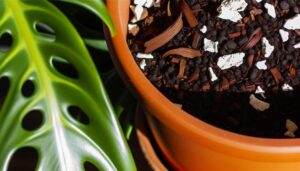Monstera Pinnatipartita Fertilizing Tips
To maintain your Monstera Pinnatipartita healthy, use a balanced, water-soluble fertilizer with an N-P-K ratio of 20-20-20. Apply every two weeks during the growing season, adjusting to once a month in slower phases.
Dilute to half strength to avoid nutrient burn. Incorporate secondary macronutrients like calcium and magnesium to support cell structure, and add micronutrients such as iron and zinc for enzymatic functions.
Monitor soil pH, aiming for 5.5 to 7, to optimize nutrient uptake. Watch for signs of over-fertilization like leaf burn and salt buildup.
There's much more to ponder to ensure your plant thrives.

Key Takeaways
- Use a balanced, water-soluble fertilizer with an N-P-K ratio of 20-20-20 for optimal growth.
- Fertilize every two weeks during active growth periods and reduce to once a month during slower growth phases.
- Dilute fertilizer to half the recommended strength to avoid nutrient burn.
- Monitor soil pH levels between 5.5 and 7 for better nutrient uptake.
- Watch for signs of over-fertilization like leaf burn and salt buildup, and adjust fertilization accordingly.
Understanding Nutrient Requirements
To ensure optimal growth for Monstera pinnatipartita, understanding the specific macronutrients and micronutrients needed by the plant is crucial. Primarily, macronutrients like nitrogen (N), phosphorus (P), and potassium (K) are crucial. Nitrogen supports strong leaf growth, phosphorus assists in root development and flowering, while potassium enhances overall plant health and disease resistance.
Additionally, secondary macronutrients such as calcium (Ca), magnesium (Mg), and sulfur (S) stabilize cell structure and chlorophyll production. Micronutrients, though necessary in smaller amounts, are equally important. Elements like iron (Fe), manganese (Mn), and zinc (Zn) facilitate enzymatic functions and chloroplast formation.
Regularly monitoring and adjusting these nutrient levels is vital to ensure your Monstera pinnatipartita maintains peak vigor and lush foliage.
Choosing the Right Fertilizer
Selecting the appropriate fertilizer for Monstera pinnatipartita involves understanding the specific nutrient formulation that caters to its growth requirements. You should choose a balanced, water-soluble fertilizer with an N-P-K ratio of 20-20-20 to guarantee an even distribution of nitrogen, phosphorus, and potassium.
Nitrogen promotes lush foliage, phosphorus supports root development, and potassium enhances overall plant health. Additionally, incorporating micronutrients like magnesium, calcium, and iron can mitigate potential deficiencies.
Opt for slow-release fertilizers if you prefer less frequent applications. Always follow the manufacturer's instructions to avoid over-fertilization, which can cause root burn and nutrient imbalances.
Optimal Fertilizing Schedule
Establishing an ideal fertilizing schedule for Monstera pinnatipartita involves understanding its growth phases and seasonal nutrient demands. During active growth periods, generally from spring to early fall, you should fertilize every two weeks. Utilize a balanced, water-soluble fertilizer with a 20-20-20 NPK ratio, ensuring an even distribution of nitrogen, phosphorus, and potassium.
Reduce feeding frequency to once a month during slower growth phases, typically late fall to winter. Always dilute the fertilizer to half the recommended strength to prevent nutrient burn. Consistent monitoring of soil pH, ideally between 5.5 and 7, enhances nutrient uptake.
Adjust your schedule based on the plant's response, watching for signs of over-fertilization like yellowing leaves or root burn.
Seasonal Fertilizing Adjustments
Seasonal adjustments in fertilizing Monstera pinnatipartita hinge on recognizing the plant's shifting metabolic needs throughout the year. During the growing season, typically spring and summer, your Monstera requires more nutrients to support rapid growth and photosynthesis. Use a balanced, water-soluble fertilizer every two weeks to sustain this vigorous activity.
As temperatures drop in fall, taper off fertilization to once a month. Winter dormancy reduces the plant's nutrient uptake; hence, fertilizing should be minimal or entirely halted. Monitor light exposure and ambient temperature, as these factors crucially influence metabolic rates.
Signs of Over-Fertilization
Detecting signs of over-fertilization in your Monstera pinnatipartita involves closely observing for symptoms such as leaf burn, nutrient imbalances, and salt buildup in the soil.
Leaf burn typically manifests as brown, crispy edges or tips, indicating excess fertilizer salts. Nutrient imbalances can cause stunted growth or distorted new leaves, as too much of one nutrient can inhibit the uptake of others.
Salt buildup in the soil becomes evident with a white, crusty layer on the soil surface, which can lead to root damage and hinder water absorption.
To mitigate these issues, you should flush the soil with water regularly and adjust your fertilization schedule, ensuring you're not applying too much or too frequently.
Conclusion
Just as a sculptor meticulously chisels marble to reveal a masterpiece, you must carefully nourish your Monstera pinnatipartita. By understanding its nutrient needs, selecting the right fertilizer, and adjusting your feeding schedule seasonally, you'll craft a thriving plant.
Avoid over-fertilization, as it's akin to overworking the marble, causing cracks. With precision and care, your Monstera will flourish, embodying the beauty of well-tended science.
Remember, balance is your chisel, and knowledge is your guide.






